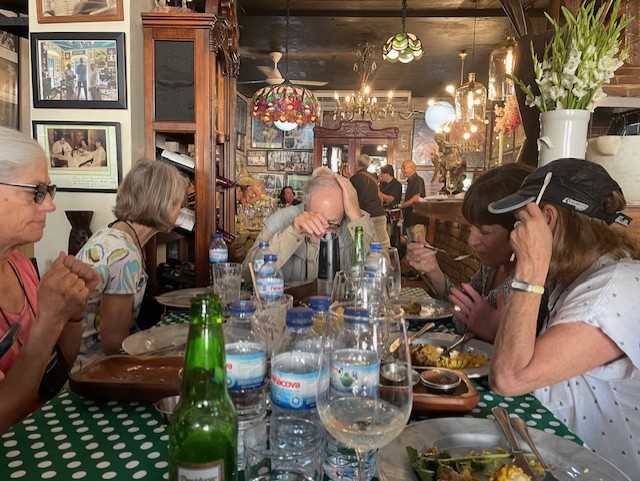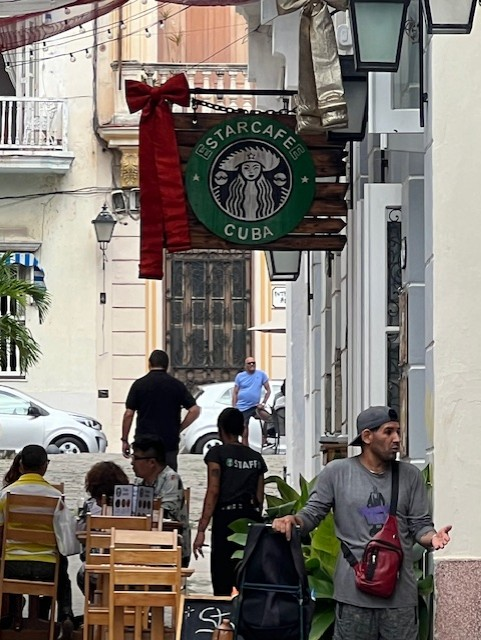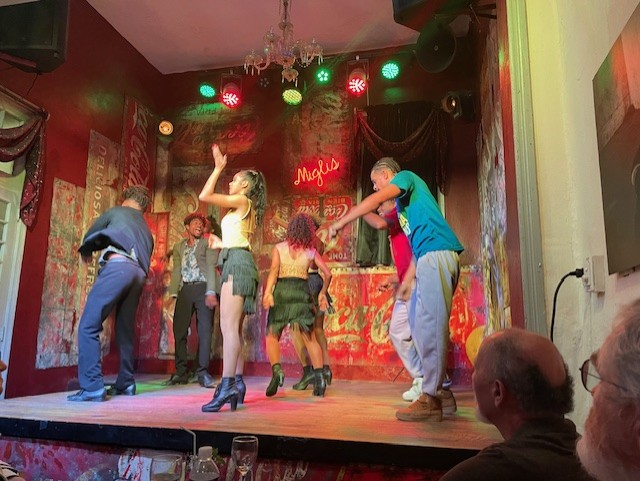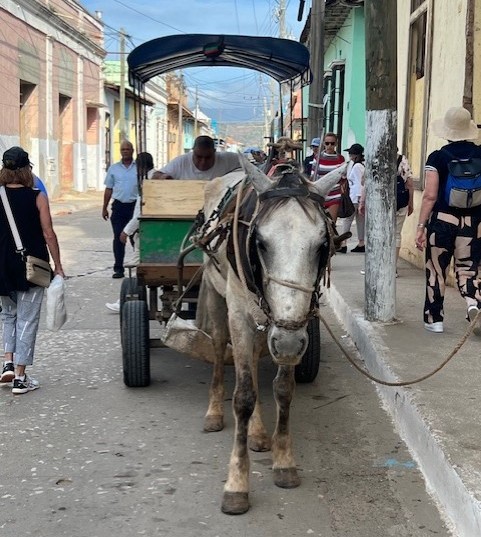Sixty-five years after the revolution, socialist regulations and the continuing embargo have brought on economic collapse and decaying cities.
-
Fall 2024
Volume69Issue4
Editor's Note: All photographs by the author unless otherwise credited.

“But what about Castro?” someone asked. “Didn’t he lead a double life, with secret mistresses, luxurious yacht, private island, multiple mansions, private security teams, secret cash accounts …?”
“Who told you that?” Jorge shot back. “Nonsense. Propaganda. What I know is this: Fidel stood for the common man!”
We’d been in Cuba just a few days, now riding a bus from Havana south across sleepy rural plains toward the old Spanish towns of Cienfuegos and Trinidad. Jorge, our Cuban guide (not his real name), was telling us about the towns, the old cars, the beat-up highway, the history, how to navigate the rest stops. (No seats on the toilets. Don’t flush the paper. You’ll clog the pipes.) Jorge, in his late 40s, had never been outside Cuba, but he spoke perfect English with no accent and was deeply conversant with global politics, finance, and life. Jorge’s wife was a university professor who drank too much coffee; his married son, a musician and teacher, had moved with his wife to the United Arab Emirates, traveling because he wanted to experience life abroad.
Growing up, Jorge had served in the Cuban military when draft age. He’d gotten a master’s degree and taught high school English before becoming a licensed tour guide, but he never joined the Communist Party. He didn’t oppose its ideology. His father had become a Communist as a government civil servant, but Jorge, even though he worked for the Cuban Tourism Ministry, saw no need.
Most young people don’t join the Party any more, Jorge told us. Nostalgia for the glory days of the revolution had grown stale over decades of hard times.
The famous revolutionary heroes of 1959 – Fidel, Che Guevara, Camilo Cienfuegos – still had their images posted everyplace in Cuba, on billboards, posters, book covers, tee shirts, you name it. Their faces stretched six stories high on the buildings surrounding Havana’s Revolutionary Square. But they were from long ago.
Jorge, talking with us during our long walks through Havana and on bus rides, didn’t hesitate to criticize his modern government. He explained the reasons why so many young Cubans wanted to leave: the bad economy, poverty, little opportunity. He explained the problems he saw with socialist economics. When asked why a compromise with the United States was so elusive, he faulted not only the reactionary American Cuban exiles in Miami – a favorite local villain - but also his own government, still reluctant to risk losing power through free and fair elections.

But for all that, Jorge had a soft spot for Fidel. Fidel stood for the people, he insisted. Fidel never wore fancy slick business suits; he wore army fatigues like a soldier. It was Fidel and his circle who overthrew the corrupt Batista regime in 1959 and restored national honor, ending domination by rich people, be they Cubans or foreigners. And it was Fidel who had kept his promises by insisting on completing the two most popular accomplishments of the regime: free universal medical care for every Cuban, rich or poor, and free universal education for every Cuban, rich or poor.
For all the negatives, these positives continued to make the regime popular, he insisted, especially among the poor, who comprised the country’s large majority. All this, and something more. All Cubans appeared to stand united against their obvious common enemy, the foreign, overseas power they never failed to mention as being responsible for their country’s economic plight: America.
Which was us. For us, as Americans, this would be no ordinary vacation.
My wife Karen and I had no special business in Cuba. We had decided to visit in January 2024 mostly out of curiosity, a winter escape, a chance to see something different. We knew about Cuba mostly just from what we read in newspapers or books or saw on TV or in old movies. We had stumbled on the opportunity to go when we became involved with a travel organization well known for its tours of exotic places with an emphasis on study and learning. The group had been leading organized trips to Cuba since the early 2000s and had gained approval from both the Cuban and American governments for its tours.
But, before even leaving home, we experienced something different about this trip: the hostility of our own government. It seemed that American policy tried at every turn to make it as difficult as possible. For instance, we learned that American travelers are barred from using American credit or ATM cards in Cuba. As a result, we each had to carry thick wads of cash to cover any incidentals or purchases – making us perfect targets for any local pickpockets or thieves.

We would be forbidden from staying in most Cuban government-owned hotels or dining in most Cuban-owned restaurants, part of the US embargo on the Island. Our government required us to keep detailed records, and hold them for inspection for five years, to demonstrate our compliance with rules strictly limiting our activities in Cuban to the strictly-defined category “Support for the Cuban People” as opposed to support for the government – tricky in a socialist economy where government was involved in most everything.
All that, and we would be barred from carrying home any amount of Cuban rum or cigars, the country’s most popular exports.
Our flight from Miami was uneventful, but Havana itself was a shock. They housed our group at the Grand Aston Hotel, a spanking new tower built by a Cuban partnership with an Indonesian corporation. It stood 20 stories tall on the Malecon, Havana’s avenue facing the Atlantic Ocean with views of the old Spanish fort. The hotel sported three restaurants, a rooftop bar, enormous swimming pool, a rich breakfast buffet, and all the modern amenities.
But step outside and you immediately see a city crumbling to pieces, a post-apocalyptic vision. Our guide Jorge, on our first meeting, told us that in Cuba, when you walk outside, always look down. The streets and sidewalks are broken, with potholes and pavement cracks everywhere and nobody to fix them. The streets have scant traffic, even during normal rush hours. Too few cars. Yes, the old American cars from the 1950s – prior to the embargo – made up the majority along with a few Ladas from the Soviet era. But it wasn’t because cars weren’t available from other countries. Cars were expensive, and hardly anyone in Cuba could afford to own one.
Then came the buildings. Beautiful structures, virtually all crumbling. Under Cuban socialism, individual people could own only an apartment or a house. Anything larger, an apartment complex, an office tower, a factory, had to be owned by the state or some specially licensed partnership. And the state these days had no money for upkeep outside a few small tourist areas. So, the buildings crumbled, year after year, decade after decade – including architectural gems from prosperous times built for the wealthiest, then abandoned.
But not all. Amid the decay, one tower along the Malecon seafront remained clean and intact, the 1957-built, 21-story Riviera Hotel, known to every Cuban schoolchild as the plaything of American Mafia leader Meyer Lansky – carefully maintained by the regime as a lasting symbol of how the US government had turned their island over to crooks.
Why didn’t anyone, American, European, even Russian, simply come in and buy some of these old houses and fix them up? Or invest in businesses, or factories, or new hotels? Despite its socialist rhetoric, the Cuban government seemed more than eager to provide partnerships or legal safe havens to pave the way.
Enter here the United States government. This is the complicated part.
Most Americans barely give it a passing thought, but today, in 2024, our country remains in a state of war against Cuba. No, we haven’t sent troops since the mercenary army of Cuban exiles we dispatched to the Bay of Pigs in April 1961, and our own troops stationed at Guantanamo Bay on Cuba’s southern tip haven’t wandered off base.

But wars today are fought by other means. More than six decades ago, in response to provocations by Fidel Castro and his 1959 revolutionaries – confiscations of American property, cozying up with Soviet Russia, sending guerrilla fighters to foment unrest abroad, all highlighted by the 1962 Cuban Missile Crisis – America imposed a network of embargoes, blacklists, travel and investment restrictions, and global financial sanctions that essentially locked Cuba and its people into a prison cell.
We talk much today about “endless wars,” started originally for good reason in moments of passion but impossible to stop as decades roll by. We also often praise the use of economic sanctions against global bad actors as a humane alternative to violence. But combine the two concepts – an endless war with no cost in human life, thus no pressing opposition and backed by a small but vocal group of aggrieved supporters, in this case the Cuban exiles – and it can truly last for generations.
Cuba thrived at first under the American embargoes. Generous aid and trade packages from Soviet Russia and its Eastern Bloc allies through the 1960s, 1970s, and 1980s more than made up the difference. But then, the Cold War ended with the collapse of Communism in Russia and Eastern Europe, and Cuba lost its benefactor. Russian cut them off. Cuba’s economy cratered, bringing poverty and isolation, never to fully recover.
This economic collapse – what Castro euphemistically called the “special period” – forced Castro to stop sending his guerrillas abroad to foment revolution in African or Central America.
Meanwhile, America made peace with its other Cold War enemies like Vietnam, though not with holdout renegades like North Korea, or more recently Iran or Russia. Castro himself relinquished power in 2011 and passed away in 2016. As early as 1992, the United Nations General Assembly started voting almost unanimously every year for ending the Cuban embargoes, in 1995, Cuba joined the World Trade Organization (WTO), and in 2009 it rejoined the Organization of American States (OAS). Under President Barack Obama, Washington and post-Fidel Havana experienced a diplomatic thaw, restoring formal ties in 2015 and loosening many travel restrictions. But the core embargo remained frozen in statute, impossible to change short of an Act of Congress.

Some things never changed. Cuba’s Communist Party continued its hold on power, despite a new constitution in 2019, and internal protests as recently as 2021 were crushed with heavy handed police beatings and arrests. Hundreds still remain imprisoned. But the last overtly hostile act by the Cuban military against America – the shooting down of two private planes operated by a Miami-based group called Brothers to the Rescue that Cuba claimed had violated its airspace – occurred in 1996, almost thirty years ago.
But the embargoes remain. In fact, rather than fading away, they’ve tightened, particularly during the recent Donald Trump Administration, spurred on by a Cuban exile community in the Miami area today numbering over 1.2 million people (including descendants of the original refugees), many still carrying wounds and grudges and hopes for some restoration of their old lives on the island before Castro and his Revolution. As a result, the Trump-era changes have mostly held so far even under President Joe Biden.
Backers of the embargo insist on the need to keep up pressure against the Havana regime. But one impact remains unmistakable: The policy continues to punish the children, grandchildren, and great-grandchildren of the people we had our original grievances with decades ago, the bulk of the eleven million people who live there today.
Which brings us back to Havana. Our trip to Cuba, structured under the embargo’s exemption for programs providing “Support for the Cuban People,” brought us into constant contract with those children and grandchildren.
In Trinidad, a UNESCO World Heritage Site on the south coast of Cuba, we met artists and sculptors. In Cienfuegos, an hour west, we heard young musicians, saw a choral group and dance company, then visited the writers and artists union. Artists actually thrive in Cuba today with the tourist trade, but writers struggle. Beyond censorship, newspapers, magazines, and books of any kind are increasingly scarce. Why? Ask, and they all point to the same villain: The American embargo has made paper expensive. Hence the rarity of newspaper or bookstores. When I asked an old poet if he had ever considered self-publishing his work, he gave me a blank stare. The concept was foreign to him.
In Havana, we saw churches and synagogues and visited a neighborhood center for senior citizens. We heard Cuban bands, met talented young dancers and musicians, spoke with teachers and community leaders. Yes, these were all things the regime wanted us to see, putting the best face on Cuban society. We understood that. But it was hard not to appreciate the spirit of these people finding ways to thrive creatively in this harsh environment.
In every city, we patronized the “paladars,” the new privately-owned restaurants recently permitted as a capitalist carveout under Cuba’s socialist system. Started in the 1990s and encouraged since the 2010s, these private businesses have emerged as the fastest growing part of the Cuban economy.

There’s a story Cubans tell about the new private restaurants. Who are the richest people in the country? Not the restaurant owners. Not the doctors, teachers, engineers, or ranking government officials. Not the musicians. Not even the generals. But the waiters. The waiters in Cuba, especially at the paladars, get paid in tips, in dollars, each dollar worth hundreds of Cuban pesos that sink each year with inflation. It wasn’t uncommon to hear of highly trained scientists and engineers with advanced degrees quitting their jobs to serve food in order to finance a better life.
I also had an unexpected chance to see Cuba’s vaunted medical system up close and, happily, it lived up to the reputation. One afternoon while walking on the Malecon – the old sidewalk along the seawall – I slipped, fell, and hit my head on some rocks. I got a bad cut over my eye that needed stitches, so our group leader whisked me to a local emergency clinic.
Here, a doctor took me right away – no forms, no checking blood pressure or pulse, just a few quick questions. No, I had no allergies. The doctor lightened the mood by telling jokes in broken English. He called me “scarface,” said I would have “raccoon eyes” and look like I had just fought Ironman. Then he put on surgical gloves and mask and went to work in a cramped room on an old table: A quick jab of anesthetic, then seven visible stitches around my eye, plus more stitches below the surface.

Two weeks later, back home in America, I showed his work to my local doctor in Northern Virginia and she marveled at the job, the stitches tight and absorbable to avoid scarring. It looked better, she said, than many she’d seen from American hospitals. For Cubans, medical care is free for all. For American tourists like me, a slight added charge on our airline fare ($25) covered full insurance. I paid nothing except some embarrassment and bad photos.
On the other hand, we saw little of the communist government during our trip: no speakers, no bureaucrats (other than our guide), no tours of government projects or buildings, nothing military other than the few tanks and airplanes at the Museum of the Revolution in downtown Havana. Our “Support for the Cuban People” structure forbade it.
Finally, those old cars. Cuba is a land haunted by nostalgia, be it shadows of Ernest Hemingway, Ricky Ricardo, the Copacabana shows, or the Riviera casino of Meyer Lansky. But these only distort the present. Yes, to American tourist eyes, all those old cars from the 1940s and 1950s, Chevys, Buicks, Lincolns, Cadillacs, and Fords with big fins and lots of chrome, give Cuban streets a Disneyland quality.
I saw an old 1959 Chevy Impala almost exactly like one my parents owned when I was a kid. And amazingly, with little access to spare parts, local Cuban mechanics reworked them and kept them running.
But to most local Cubans, those cars represent something different: the American embargo. When they see affluent American tourists like us riding around town in them, honking horns and blocking foot-traffic, the image simply reminds them of what they lost and why.
Pre-Revolution 1950s Cuba was no golden age. Despite an affluent middle class in Havana, those years spawned a revolution precisely because conditions for most Cubans were unacceptable: the abusive dictatorship of Batista, the hopeless poverty of the Cuban majority, the rigid class, economic, and political structures that virtually begged to be overthrown. This does not excuse the excesses of the Cuban Communists, but there is no going backward to the old regime. Neither side, Cuban nor American, should find it tolerable.
I saw an old 1959 Chevy Impala almost exactly like one my parents owned when I was a kid.

One would hope that, within our lifetimes, wise people in both countries, Cuba and America, would find a way to settle this! As with many intractable global quagmires, the outlines of a solution seem obvious: America could offer to lift its sanctions in exchange for Cuba’s government allowing some form of democracy, free, fair elections with international observers and multiple parties, and some real of symbolic restitution for the Cuban exiles.
Such a peace could unleash a flood of creative energy, economic, cultural, and human. Potential American investors would find an eager, educated workforce, vast tracts of undeveloped farmland and beachfront, natural resources, and Caribbean sun. The potential gains from even a conservative, tightly controlled development plan would be more than enough to go around.
But to reach a settlement, both sides would have to relent – both the Cuban government and the American skeptics. Otherwise, the future holds little optimism: continued disintegration of Cuban life and continued pushing of the island country into the arms of hostile powers like China, Venezuela, and Russia, repeating the worst mistakes of the 1950s and 1960s.
Prospects don’t look promising. Two left-leaning American members of Congress, Pramila Jayapal and Ilhan Omar, visited Cuba in February 2024, to urge rapprochement. But, once home, they were quickly blasted by pro-embargo Congress members from both sides of the aisle for coddling dictators and communists.
After we left Cuba at the end of our tour, Karen and I spent a few days in Miami’s South Beach to enjoy some time before going home. Here, we made a point to sample the many Cuban restaurants – yes, the food and mojitos were excellent – and met many young Cubans who have made their lives in America. When we told them about our trip, we heard no hostility, no rants about communists or confiscated property. Instead, they asked questions. A few mentioned having visited the Island, or still keeping contact with family members there. Some complained about how hard it was to make the quick trip.
There is plenty of good will on both sides of the Cuban Straights. Even after six decades, people are not helpless. There ought to be a way to end this endless war. Someone from one of the extremes just needs to take the first step.

